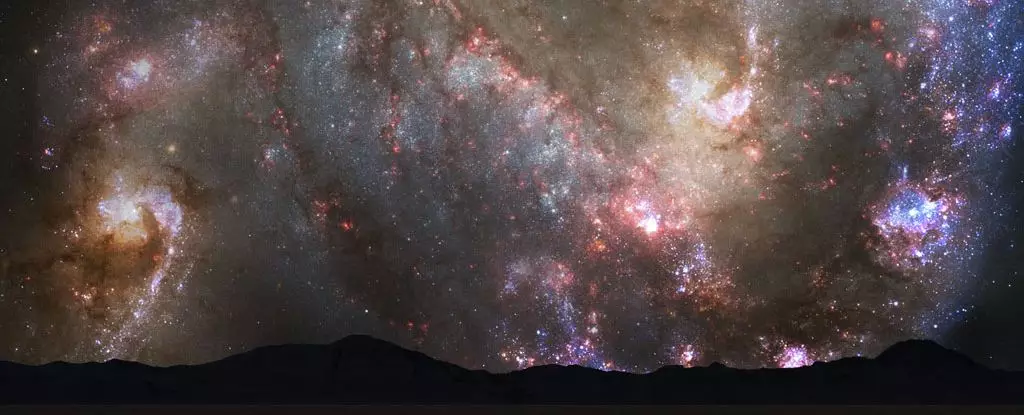In a striking revelation, researchers led by astrophysicist Till Sawala from the University of Helsinki have cast a new light on the anticipated cosmic collision between the Milky Way and Andromeda galaxies. Long considered an imminent event, often informally dubbed “Milkomeda,” this merging of titans may not be as certain as previously thought. The analysis unveils an almost 50-50 chance that the two galaxies might either collide or merely glide past one another in the vast nothingness of space. This revelation challenges the long-held belief that our galaxy’s fateful encounter with Andromeda is a mere formality in the grand timeline of cosmology.
Sawala emphasized that while earlier predictions were founded on solid calculation, the revised outlook introduces a layer of complexity regarding the ultimate fate of our Local Group. Existing models, primarily focused on past occurrences, often neglect the dynamic influences that can shape future celestial events. Thus, the findings underscore the necessity for continuous inquiry and recalibration of our understanding as new data emerges.
The Intricacies of Galactic Dynamics
The potential collision is not merely a binary affair between two massive spirals. The gravitational mechanics at play within our Local Group – which includes the Triangulum galaxy and the Large Magellanic Cloud – add layers of complexity to the future of Milky Way and Andromeda. The scientists’ simulations revealed how the presence of these additional celestial bodies significantly affects the probability of a merger. For instance, when Triangulum was considered, the likelihood of a merger surged to two in three, whereas adding the Large Magellanic Cloud, in place of Triangulum, dramatically lowered the chance to one in three.
These updates suggest that our understanding of galactic movements must take into account numerous factors, reflecting a broader cosmic environment that is anything but static. The subtle gravitational influences among these neighboring galaxies showcase the intricate interplay of forces that can radically alter the trajectories and fates of colliding galaxies.
From Past to Future: The Shift in Perspective
Sawala notes the traditional astrophysical focus has predominantly been on understanding past events, exploring the journey of galaxies to their current state. However, the shift towards contemplating future interactions is crucial for shaping our cosmic narrative. The findings urge astronomers to approach the galaxy’s future with a sense of curiosity, embracing the uncertainties that accompany long-term predictions. As Sawala aptly stated, while we possess remarkable observational tools now, the quest for knowledge regarding future events is only beginning.
The selection of a 10 billion-year timeframe for the simulations serves as both a practical measure and a nod to the inherent unpredictability of cosmic events. The sheer expansiveness of time renders many factors difficult to anticipate, urging a cautionary approach in cosmic forecasting. Each simulation outcome presents a possible pathway, creating a landscape rich with possibilities yet fraught with uncertainty, echoing the multifaceted nature of cosmic evolution.
Advancing Technologies and Future Discoveries
The utilization of data from cutting-edge instruments such as the Hubble and Gaia space telescopes exemplifies the fusion of technology and theoretical science that drives modern cosmic research. As advancements in observation techniques continue to evolve, our understanding of the gravitational interactions and mass estimates within our cosmic neighborhood will only grow more precise. Such refinements in data will cultivate deeper insights into the mechanics governing galaxy behavior, allowing scientists to simulate future interactions with greater accuracy.
Moreover, the implications of discovering that the fate of Milky Way and Andromeda is still shrouded in uncertainty resonate beyond the confines of mere speculation. This ongoing inquiry speaks to the fluidity of knowledge in astronomy and the importance of adapting to new evidence continuously. As more data becomes available, it may very well reshape our assumptions about galactic collisions and highlight the remarkable complexities of the universe we inhabit.
Broader Implications for Cosmic Understanding
The insights gained from the collision probability of Milky Way and Andromeda hold significant implications beyond our immediate cosmic backyard. Understanding how nearby galaxies interact resonates with larger questions about galaxy formation, dark matter dynamics, and evolutionary pathways of the universe. It underscores the necessity of considering not just individual galaxies, but the ecosystems of galaxies that coalesce into groups, influencing each other through gravitational ties predicated on their mass and distance.
The uncertainty surrounding the eventual fates of the Milky Way and Andromeda serves as a reminder of the boundless mysteries that still await exploration. As we probe deeper into these cosmic enigmas, we not only elevate our fascination with the universe but also deepen our understanding of our place within it. Science thrives on revisiting established truths in light of fresh data, revealing a cosmos that is not static but vibrantly alive, teeming with possibilities yet to be realized.

